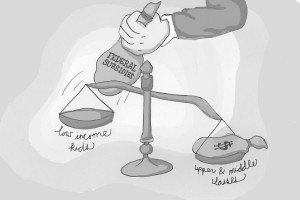New AP cuts hurt low-income students
Advanced Placement classes have been a part of both public and private high school education since 1955. But recent federal budget cuts that decrease funding for AP programs beg the question: Who are the classes really benefiting?
Congress has officially cut federal financing for high schools and programs offering AP courses from $43 million to slightly under $27 million, a decrease of nearly 50 percent. This cut hits low-income students the hardest. Though those students have been eligible for AP exam fee waivers, state education officials are now notifying high schools that low-income students will have to pay $15 for each of the first three exams they take and $53 for any additional exam.
Even if the AP courses remain free, participation in the AP program, which is housed by the College Board, has very little value without taking the exam. Those two letters on a high school transcript won’t impress college admissions officers or scholarship committees nearly as much without the scores to back them up.
So although upper- and middle- class students who can still afford to pay for their exams continue to reap the benefits of the AP program, low-income students are left unable to validate a class’s worth of hard work.
As Louis Toro, the Advanced Placement coordinator at Classical High School in Providence, R.I., told The New York Times, the best many students can do is to choose among exams, which many of Toro’s students were forced to do.
More importantly, the classes alone won’t count for college credit. The irony of this situation is that low-income students are the demographic that stand to benefit most from AP exams, because the college credit they earn by passing can save them thousands of dollars in college tuition in the years to come.
They also have the greatest need for college scholarships, some of which might use AP scores as selection criteria.
The AP program is supposed to offer American high school students an opportunity for free and convenient access to college-level courses. Just like private schooling, professional tutoring and personal college counselors, however, the program has proven to be a luxury available only to some.
And though the recent budget cuts have made the situation much worse, low-income students have experienced marginalization at the AP program’s hands for years.
Limited resources, overcrowding and lack of qualified teachers often restrict the number of AP courses a low-income high school can offer and the number of students who are eligible to take them. As reported by College Board in 2010, only 33.7 percent of public high schools offered even basic AP courses in the four core subject areas: language arts, math, science and social studies.
Low-income students also cannot usually afford AP preparation books, CDs and other preparatory media. Other students might spend nearly $100 buying five or six of these and using them to cram for the exam, or to supplement their regular course work year round.
Right now, the College Board, SAT testing, the CSS profile and a host of other costly college planning resources, have complete control over determining which high school students are rewarded for the advanced work they undertake.
High schools and colleges alike have to find a better, less expensive way to affirm that work — one that doesn’t need a federal subsidy. Is a national standardized exam the only way that this can be achieved? What about writing samples, school interviews, college-sponsored placement tests and grades?
The AP program can be an enriching educational experience, but its benefits only go as far as funding allows. Educators need to find a way around the program’s expenses, or risk alienating low-income students from its distinct advantages altogether.
Francesca Bessey is a freshman majoring in narrative studies.


Collegeboard is just another greedy corporation. Is there really any logic in charging that much for a test in the first place?
Does anyone seriously think that there are families who can’t fork out $15 for an AP exam?
Well, someone’s a bit snobbish. Wouldn’t you say?
@Francesca, please don’t do statistics a disservice: it’s approximately 38% in the cut, not 50%.